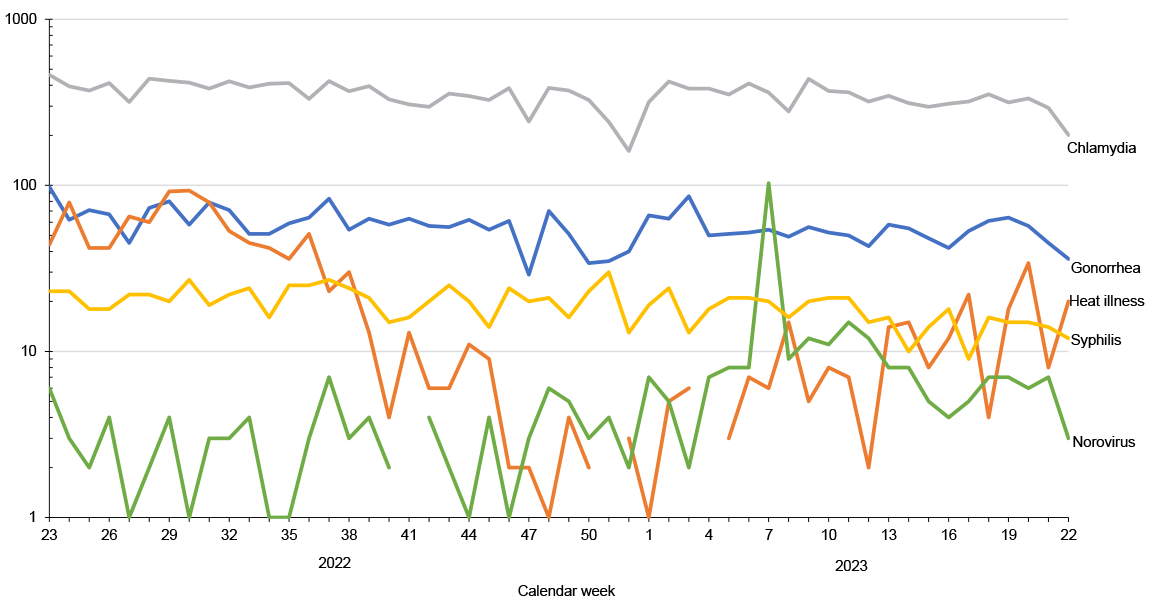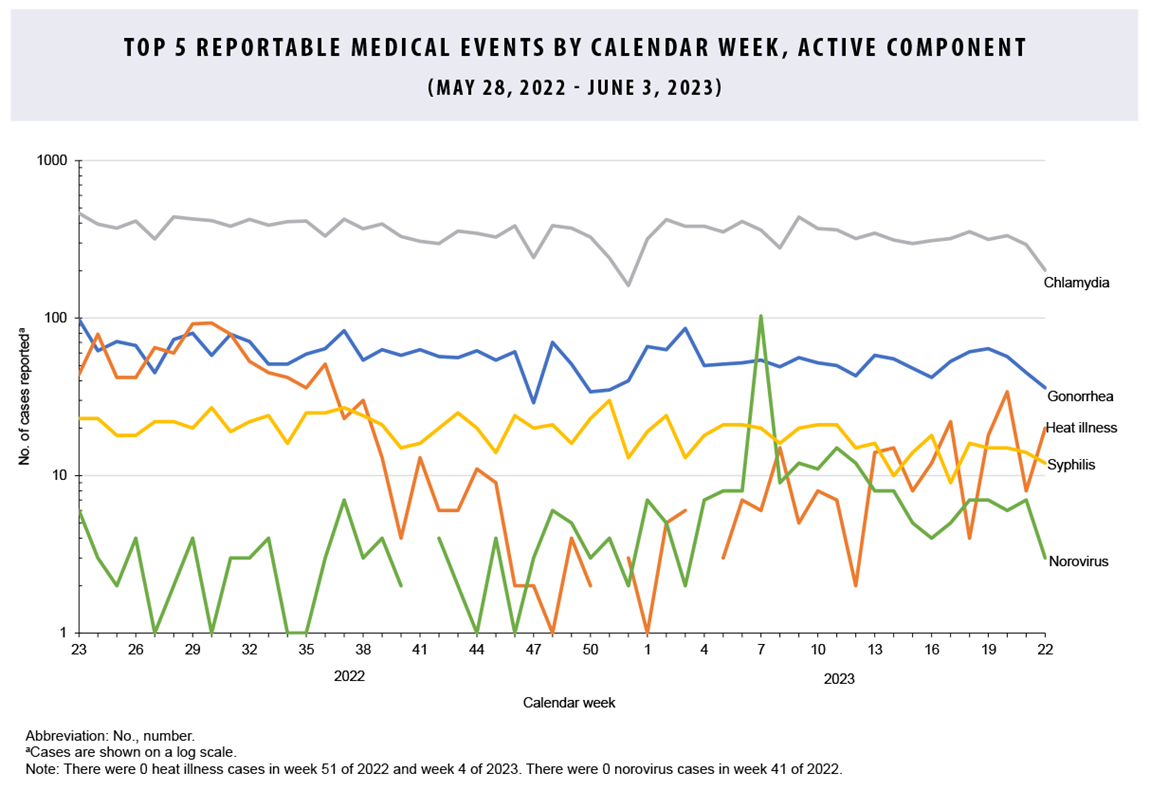Reportable Medical Events, Military Health System Facilities, Week 22, Ending June 3, 2023
 Graph depicting the frequency of the five most common reportable medical events within the Military Health System over the preceding year.
Graph depicting the frequency of the five most common reportable medical events within the Military Health System over the preceding year.
Reportable Medical Events are documented in the Disease Reporting System internet by health care providers and public health officials across the Military Health System for the purpose of monitoring, controlling, and preventing the occurrence and spread of diseases of public health interest or readiness importance. These reports are reviewed by each service’s public health surveillance hub. The DRSi collects reports on over 70 different RMEs, including infectious and non-infectious conditions, outbreak reports, STI risk surveys, and tuberculosis contact investigation reports. A complete list of RMEs is available in the 2022 Armed Forces Reportable Medical Events Guidelines and Case Definitions.1 Data reported in these tables are considered provisional and do not represent conclusive evidence until case reports are fully validated.

Total active component cases reported per week are displayed for the top five RMEs for the previous year. Each month, the graph is updated with the top five RMEs, and is presented with the current month’s (May 2023) top five RMEs, which may differ from previous months. COVID-19 is excluded from these graphs due to changes in reporting/case definition updates in 2023.

References
- Armed Forces Health Surveillance Division. Armed Forces Reportable Medical Events. Accessed April 6, 2023. https://www.health.mil/Military-Health-Topics/Health-Readiness/AFHSD/Reports-and-Publications/Armed-Forces-Reportable-Medical-Events
- Defense Manpower Data Center. Department of Defense Active Duty Military Personnel by Rank/Grade of Service, October 31, 2022. https://dwp.dmdc.osd.mil/dwp/app/dod-data-reports/workforce-reports
- Defense Manpower Data Center. Armed Forces Strength Figures for January 31, 2023. https://dwp.dmdc.osd.mil/dwp/app/dod-data-reports/workforce-reports
- Navy Medicine. Surveillance and Reporting Tools–DRSI: Disease Reporting System Internet. https://www.med.navy.mil/Navy-Marine-Corps-Public-Health-Center/Preventive-Medicine/Program-and-Policy-Support/Disease-Surveillance/DRSI
You also may be interested in...
Article Around MHS
Apr 15, 2022
Nigerien and U.S. doctors alongside U.S. joint service medical specialists established a temporary field clinic to provide medical treatment to citizens of Ouallam and the surrounding areas as a part of a medical civic action program (MEDCAP) in Ouallam, Niger, March 16, 2022.
Article
Apr 11, 2022
During his speech at HIMSS, Lt. Gen. Place discusses clear and present dangers to military medical care.
Article
Apr 8, 2022
Dr. Jay Montgomery is a medical director for the Defense Health Agency’s Immunization Healthcare Division’s North Atlantic Region Vaccine Safety Hub. In his role, Montgomery helps address vaccine and immunization questions and concerns.
Article
Apr 6, 2022
Military Medical officials, including Army Lt. Gen. (Dr.) Ronald J. Place, Defense Health Agency director, back FY 23 Budget before the Senate Appropriations Committee, March 29, 2022.
Article
Apr 5, 2022
Rear Adm. Brandon Taylor was recently appointed to be the new director for the Defense Health Agency’s Public Health directorate. In an interview, he discussed how he is approaching his new role, his goals for Public Health within DHA, and the importance of Public Health to a medically ready force and a ready medical force.
Article
Apr 1, 2022
Exertional (or exercise-associated) hyponatremia refers to a low serum, plasma, or blood sodium concentration (below 135 mEq/L) that develops during or up to 24 hours following prolonged physical activity. Acute hyponatremia creates an osmotic imbalance between fluids outside and inside of cells.
Article
Apr 1, 2022
Exertional heat illness (hereafter referred to as heat illness) spans a spectrum from relatively mild conditions such as heat cramps and heat exhaustion, to more serious and potentially life-threatening conditions such as heat injury and exertional heat stroke (hereafter heat stroke).
Article
Apr 1, 2022
Exertional rhabdomyolysis is a potentially serious condition that requires a vigilant and aggressive approach. Some service members who experience exertional rhabdomyolysis may be at risk for recurrences, which may limit their military effectiveness and potentially predispose them to serious injury.
Article
Apr 1, 2022
From 2020 to 2021, the rate of incident heat stroke was relatively stable while the rate of heat exhaustion increased slightly
Report
Apr 1, 2022
 .PDF |
1.51 MB
.PDF |
1.51 MB
A monthly publication of the Armed Forces Health Surveillance Division. This issue of the peer-reviewed journal contains the following articles: Exertional heat illness at Fort Benning, GA: Unique insights from the Army Heat Center; Update: Heat illness, active component, U.S. Armed Forces, 2021; Update: Exertional rhabdomyolysis, active component, U ...
Article
Mar 21, 2022
Lessons learned from the COVID-19 pandemic has made the military medical community stronger and will help when confronting the next crisis, whether that’s another pandemic, a new conflict or natural disaster
Article
Mar 8, 2022
Top military health leaders highlight the importance of preparing for the future to ensure both a medically ready force and a ready medical force.
Article
Mar 1, 2022
Since the official introduction of laser refractive surgery into clinical practice throughout the Military Health System (MHS) in fiscal year 2000, these techniques have been heavily implemented in the tri-service community to better equip and improve the readiness of the U.S. military force.
Article
Mar 1, 2022
SARS CoV-2 and the illness it causes, COVID-19, have exacted a heavy toll on the global community. Most of the identified disease has been in the elderly and adults.
The goal of this analysis was to ascertain if user-built ESSENCE queries applied to records of outpatient MHS health care encounters are capable of detecting MIS-C cases that have not ...
Article
Mar 1, 2022
Malaria infection remains an important health threat to U.S. service members who are located in endemic areas because of long-term duty assignments, participation in shorter-term contingency operations, or personal travel. In 2021, a total of 20 service members were diagnosed with or reported to have malaria.
You are leaving Health.mil
The appearance of hyperlinks does not constitute endorsement by the Department of Defense of non-U.S. Government sites or the information, products, or services contained therein. Although the Defense Health Agency may or may not use these sites as additional distribution channels for Department of Defense information, it does not exercise editorial control over all of the information that you may find at these locations. Such links are provided consistent with the stated purpose of this website.
You are leaving Health.mil
View the external links disclaimer.
Last Updated: August 24, 2023